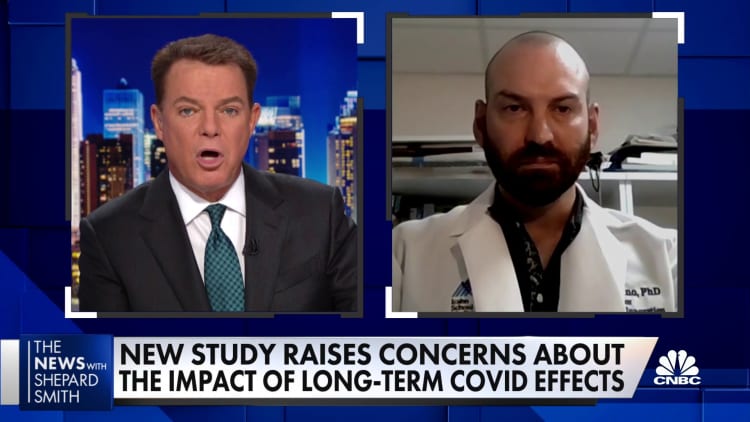Long Covid has affected as many as 23 million Americans to date — and it's poised to have a financial impact rivaling or exceeding that of the Great Recession. By one estimate, the chronic illness will cost the U.S. economy $3.7 trillion, with extra medical costs accounting for $528 billion.
Costs on a household and national scale are tough to quantify because the illness — also known as long-haul Covid, post-Covid or post-acute Covid syndrome — is so new. Anyone with a prior Covid-19 infection is susceptible, regardless of factors such as age, health or vaccine status.
Symptoms, which number in the hundreds, can range from mild to severe and may persist for months or even years.
David Cutler, an economist at Harvard University who projected the $3.7 trillion economic cost of long Covid, estimates the individual medical costs of the disease to be about $9,000 a year, on average. However, typical costs can range from roughly $3,700 up to almost $14,000, Cutler said.
Costs can be much higher, depending on the severity of illness. And because symptoms often impact a person's ability to work, someone suffering from long Covid may not be able to lean on a regular paycheck — or employer-sponsored health insurance — to help cover those medical bills.
Cutler's financial estimate draws on prior research into treatment for myalgic encephalomyelitis, a condition also known as chronic fatigue syndrome, or ME/CFS.
Dr. Greg Vanichkachorn, medical director of the Mayo Clinic's Covid Activity Rehabilitation Program, said those estimates are the best approximation right now, since treatment and evaluation for long Covid are similar to those for ME/CFS. There is no cure or approved treatment for ME/CFS; as with long Covid, patient symptoms are merely treated or managed.
"I think it is important to note that this, again, is an estimate," Vanichkachorn said. "As new treatment measures come out, things could get more expensive or, hopefully, more affordable."
"That's the nature of the word 'long-haul' — it can be an open box of costs for a while," Vanichkachorn said.
'People are trying all sorts of treatments'
Getting an official long Covid diagnosis can be challenging, which can compound early expenses.
The afflicted may undergo a battery of tests to rule out other ailments, for example. Or doctors may refer patients to specialists for treatment if they're unfamiliar with long Covid or unwilling to entertain it as a possibility.
Medical professionals typically treat infectious disease by identifying the invasive organism and attacking it. But that's not what's happening with long Covid.

Instead, doctors treat symptoms of the disease, not the disease itself, said Dr. Jeff Parsonnet, an infectious disease physician who started the Post-Acute Covid Syndrome clinic at Dartmouth Hitchcock Medical Center.
Some of the most common long Covid symptoms include fatigue, post-exertional malaise, chronic pain, cognitive dysfunction (also known as "brain fog"), neurological tremors, depression, anxiety and cardiac or pulmonary impairment, according to the U.S. Department of Health and Human Services. Long Covid can also cause other chronic conditions such as diabetes, myalgic encephalomyelitis or chronic fatigue syndrome and heart disease, HHS said.
Treatment is more about symptom management: If a patient experiences fatigue, doctors may recommend physical therapy; if pain, then pain medication; if brain fog, perhaps speech or occupational therapy; if depression or insomnia, perhaps sleep studies, counseling or psychiatric evaluation.
"The real difficulty in treating patients with long Covid is, we don't know what causes it," Parsonnet said. "People are trying all sorts of treatments, but it's guesswork at this point.
"They don't cure anything, but they help people cope better," he said, describing the treatments as "labor intensive and expensive."
Health insurance is essential — if you can get it
Health insurance may cover some or most expenses associated with diagnosis and treatment — that is, for those who have it.
Here's what that looks like for three patients with long Covid:
Uninsured and weighing specialist visits against rent
Rosa Santana, 56, is a self-employed yoga instructor in south Florida. She doesn't have health insurance, and so she can't afford to visit specialists, despite feeling like she's "been living in a different body" since a Covid infection in May 2020.
"Every time I go somewhere, I know it's going to be $300 or $400, and [I wonder], 'Will I make my rent?'" Santana said of doctor visits.
Yoga used to be a form of health care for her. Now, it doesn't offer the relief it used to; doing a headstand can cause heart palpitations and dizziness for days afterward.
Long Covid has impacted Santana's ability to work, and her income stream to cover any medical bills. Before, she was like the "Energizer bunny"; now, she schedules two private yoga sessions with clients and it's "time to rest," she said.
Hitting annual out-of-pocket max with a single infusion
Donna Pohl hits her insurance plan's yearly out-of-pocket maximum — about $3,500 — after just one infusion for common variable immunodeficiency, or CVID.
Pohl, 56, was healthy before a severe case of Covid, for which she was hospitalized in fall 2021. Now, CVID — a complication resulting from long Covid — puts her at increased risk of infections. Without insurance, Pohl would pay more than $10,000 for each infusion; she needs them monthly.
Pohl, who lives in Bettendorf, Iowa, has a roster of 10 doctors, including a primary care physician and nine specialists.
In early 2022, she was diagnosed with Mast Cell Activation Syndrome, a disease that causes severe allergic reactions. She's had pneumonia three times in a year. Pohl falls often due to "neuropathy," a type of nerve damage; she ruptured a ligament in her left hand in a recent fall and needs surgery to repair it.
"I'm a year out, and I'm still getting new symptoms," she said.
Pohl, a nurse practitioner at a hospital, counts herself lucky in one sense: She can't work her grueling emergency-room shifts right now, but the hospital kept her job (and her employer-sponsored health insurance) intact.
I'm a year out, and I'm still getting new symptomsDonna Pohlnurse practitioner
Without insurance coverage, costs for Pohl's 156 medical claims through October this year would have amounted to more than $114,000, records show.
Like many who suffer from long Covid, Pohl seeks relief from crippling symptoms wherever it's available.
That means she pays about $300 to $400 a month, on average, for many supplements and therapies that aren't covered by insurance: chiropractic work, nutrition consultations and hyperbaric oxygen, which has "by far" been the best treatment, she said.
She lives on 60% of her prior income from a long-term disability insurance policy — which, in the best-case scenario, will continue until early 2024.
COBRA coverage and a $4,000 deductible
Sam Norpel, 48, lost her job in June. Debilitating symptoms — including unpredictable bouts of broken speech, cognitive issues, chronic fatigue and severe migraines with prolonged screen time — made it impossible for the former e-commerce executive to keep working.
Norpel, who lives outside Philadelphia, was able to negotiate that the employer pay her COBRA premiums for a year so she could keep her employer-sponsored health insurance.
Even with the health plan, the family paid roughly $4,000 out of pocket to hit the plan's annual deductible. Norpel's husband, who'd been out of work to care for their kids, is planning to return to the labor force partly to avoid losing workplace health coverage.
'People ... do get better,' but it's hard to see specialists
There are nearly 250 post-Covid clinics in the U.S., according to Survivor Corps data as of early November. (A provider with multiple physical clinics is only counted once.) The list is growing steadily: There were 178 in January.
Even so, skyrocketing demand for specialists to treat long Covid means the afflicted can spend up to a year waiting for an appointment, according to the U.S. Department of Health and Human Services.
Norpel reached out to the Mayo Clinic in April, but the next available consultation was about four months later, in August.
That's the nature of the word 'long-haul' — it can be an open box of costs for a while.Dr. Greg Vanichkachornmedical director of the Mayo Clinic's Covid Activity Rehabilitation Program
An additional hurdle: She also had to pay her way to get there — a hotel room for a week and round-trip airfare from Pennsylvania to Minnesota. She also can't get a follow-up appointment with a neurologist until February next year.
"There are so many of us now that it's taking months to see professionals," she said of long Covid patients.
When it comes to treatment, however, time is of the essence. Early intervention — generally less than four months from infection — has yielded better outcomes for patients, Vanichkachorn said.
"Despite all the doom and gloom out there, people actually do get better," he said.
Patients at his clinic typically return to their normal, baseline function four to six months after treatment starts, he explained.

Time alone generally doesn't cure long Covid symptoms; it often requires some form of rehabilitation. Months of low activity can lead to serious physical deconditioning, compounding patients' malaise. Physical and occupational rehab helps strengthen muscles and aids patients in reframing their daily lives as they recover, Vanichkachorn said.
"People are really sick of being sick," he said. "They try to push themselves way too hard. "It's really difficult to tell people we have to go slower, and that's the only way we can get you better as fast as you can."
Treatment delays can have broader financial impacts, too. Patients are more likely to be denied financial assistance from disability insurance without a diagnosis and certifications from specialists, HHS said. They may also face more challenges requesting workplace accommodations.
Despite slow progress, patients and medical experts remain optimistic. The U.S. government has more than 72 active long Covid research programs in place, according to HHS. One of them, the RECOVER initiative, led by the National Institutes of Health, has about 7,000 patients enrolled at clinical sites. The CDC's Innovative Support For Patients with SARS-CoV-2 Infections (or, INSPIRE) is enrolling up to 6,000 adults.
"The scale of long Covid morbidity and the breadth of its clinical manifestations represent an unprecedented, but not insurmountable, challenge," according to the HHS' National Research Action Plan on Long COVID.
The research is still in its early stages, Vanichkachorn said.
"We may have a brand-new treatment regimen two months from now and people can get suddenly get better," he said.





